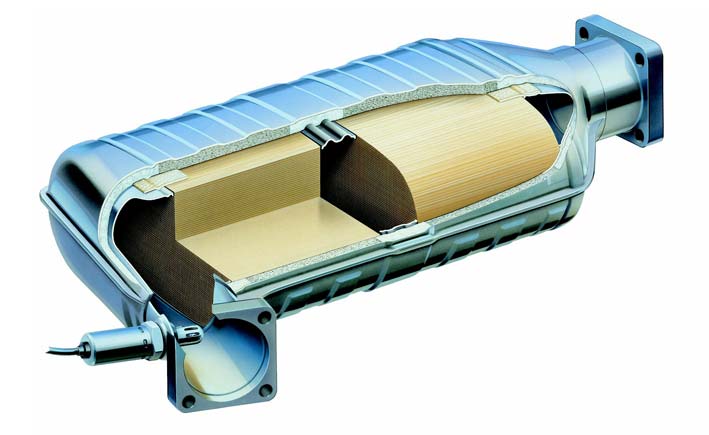Catalytic converter
Catalytic converters (CAT) are designed to turn harmful constituents of exhaust emitted by internal combustion engines into harmless gases by means of a chemical reaction. A catalytic converter is therefore an important part of modern emission purification systems for SI and diesel engines.
Function
Catalytic converters (CAT) are designed to turn harmful constituents of exhaust emitted by internal combustion engines into harmless gases by means of a chemical reaction.
Structure of catalytic converters
 A catalytic converter consists of a stainless-steel casing that houses a metallic (metalith) or ceramic (monolith) substrate. This substrate has a very large number of fine channels running through it along its length. The aim here is to create the greatest possible surface area to optimise the catalytic effect. The surface of the substrate is coated with a highly porous layer (washcoat) to which precious metals (platinum, palladium and/or rhodium) are added in suspension. It is these precious metals that are the actual catalysts initiating the chemical reactions required to purity the exhaust gases.
A catalytic converter consists of a stainless-steel casing that houses a metallic (metalith) or ceramic (monolith) substrate. This substrate has a very large number of fine channels running through it along its length. The aim here is to create the greatest possible surface area to optimise the catalytic effect. The surface of the substrate is coated with a highly porous layer (washcoat) to which precious metals (platinum, palladium and/or rhodium) are added in suspension. It is these precious metals that are the actual catalysts initiating the chemical reactions required to purity the exhaust gases.
Types of catalytic converters
EOBD
 Replacement catalytic converters for Euro 3 and Euro 4 vehicles with European On-Board Diagnostics (EOBD) are known as EOBD-capable catalytic converters. Electronic On-Board Diagnosis is mainly found in recent vehicle models. This function monitors all emissions-relevant components and sensors while the vehicle is on the road. It registers any malfunctions and warns the driver, for example with an indicator light (MIL). The latest generations of diesel vehicles are generally equipped with the EOBD function.
Replacement catalytic converters for Euro 3 and Euro 4 vehicles with European On-Board Diagnostics (EOBD) are known as EOBD-capable catalytic converters. Electronic On-Board Diagnosis is mainly found in recent vehicle models. This function monitors all emissions-relevant components and sensors while the vehicle is on the road. It registers any malfunctions and warns the driver, for example with an indicator light (MIL). The latest generations of diesel vehicles are generally equipped with the EOBD function.
Oxidation catalytic converter
Diesel engines usually function with a large amount of excess air, so that the exhaust gases contain high levels of oxygen. Catalytic converters for diesel engines oxidises- carbon monoxide (CO) to carbon dioxide (CO2) and
- hydrocarbons (HC) to carbon dioxide (CO2) and water vapour (H2O).
Three-way catalytic converter
The three-way catalytic converter is designed for SI engines. At operating temperature it converts:- unburnt hydrocarbons (HC) into CO2 and water vapour (H2O)
- carbon monoxide (CO) into carbon dioxide (CO2)
- nitric/nitrogen oxide (NO/NO2) into nitrogen (N2) and oxygen (O2).
Safety
For catalytic converters manufactured with a ceramic monolith, mats are used to fix the substrate in place. They protect the catalytic converter from impacts and seal off secondary exhaust flows. In the past fine ceramic fibres were used here but they were widely suspected as being carcinogenic. A "green mat" was then introduced for greater environmental compatibility. Green mats are either made from bio-soluble fibres (which dissolve quickly in body fluids to prevent any harm to the organism) or are not respirable due to their size.
Depreciation
Catalytic converters are subject to natural ageing. This is partly caused by the high temperatures (sometimes over 800 °C) and mechanical stresses (vibrations) that occur during normal vehicle operation. This can cause the coating of precious metals on the substrate to degrade over time. Today's catalytic converters are assumed to have an average lifespan of 80,000 to 100,000 km. Apart from bottoming the CAT when driving over raised obstacles, the following factors may also cause premature ageing of the converter:
Catalyst contamination
If the engine burns too much oil, the additives it contains may be deposited on the surface of the catalytic converter, thus sealing it. This stops the exhaust gases coming into contact with the precious metals, meaning the catalytic converter no longer functions properly. Catalyst contamination can also occur if you frequently make short journeys. In this case however, the CAT can often be regenerated by going on a long trip down the motorway. At one time filling up with leaded petrol was a common risk of contamination, but nowadays this can come about only if you happen to be abroad. Take special care when abroad to ensure you fill up only with unleaded fuel (unleaded, sans plomb).
Melting of the catalytic substrate
Faults in the ignition or fuel management system can lead to unburnt air-fuel mixture finding its way to the catalytic converter and burning up on the surface of the CAT. This can cause temperatures in the CAT to exceed 1000 °C, so destroying the substrate. You should therefore go to a garage at once if you notice any faults in the ignition or fuel management system.
Environmental protection
Modern exhaust aftertreatment systems significantly contribute to a marked improvement in the protection of human health. The process of internal combustion in the engine produces not only the main constituents of water (H2O), carbon dioxide (CO2) and nitrogen (N2), but also the harmful substances:
- Carbon monoxide (CO)
- Hydrocarbon (HC)
- Nitrogen oxides (NOX)
- Sulphur dioxide (SO2)
- In particular, soot particles (PM) in the case of diesel engines.
Katalysator Bilder
- Bild 1: Katalysator ©Eberspächer
- Bild 2: Partikelfilter ©Eberspächer
- Bild 3: Katalysator Schaubild
- Bild 4: Krümmer-Katalysator







